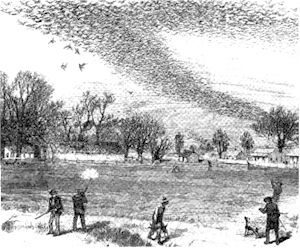What has become of the Wild Pigeon
By
Walter B. Brooks

Passenger Pigeon Shoot,
What has become of them? All whose
memory can carry them to the years "befo de wah" will probably
recall most vividly the immense flights of wild pigeons that
darkened the skies, day after day, as they passed to winter
quarters further South and whose seemingly endless flock and
incomputable numbers aroused the wonder of everyone. It did seem
as if their extinction, or even diminution, would be the work of
centuries and would equal in difficulty the famed labors of
Hercules. But what has become of them?
I have penetrated the ranges of the
Rocky Mountains at all seasons and they are not there. They pass
no more over the wide plains of Colorado and Kansas, if they
ever did they are not seen now, over the rich grain fields and
prairies of Missouri, Illinois. Indiana, or Ohio. They swarm and
roost on none of the slopes of the Alleghany or Blue Ridge
Mountains, as of yore. We hear no more about them from North,
South. East or West and it seems as if they had entirely
disappeared, from the earth.
I recall distinctly the great "finish
line" that filled the fields around Louisville, Kentucky, in the
fall of 1859, and which met with such reckless courage and
advance of the great army of wild pigeons, that swarmed down
from the North. For days there was the constant sound of battle
a ceaseless roar of guns, sad precursor as it now seems of a
more disastrous invasion, and a bloodier war. We slew our
thousands and tens of thousands, but their numbers seemed
undiminished, and the invasion unchecked.
In 1863 I visited a pigeon roost in
central Kentucky, and it was a sight never to be forgotten. It
extended over many acres of forest and millions seemed to have
gathered there. There was a constant cracking and breaking of
the too heavily laden branches. Thousands of birds were
fluttering in the air and on the ground, with a noise as of a
tornado. Men and boys were threshing them down with sticks; and
these with, the flash of torch and lantern, and the roar of
guns, made up a scene and sound seldom equaled. Our party
carried home two large sacks full of dead birds on our horses,
and many others did the same. The last great flight I ever saw
or heard of was in 1873, on the western slope of the Alleghany
Mountains in West Virginia, on the headwaters of Gauley river
and in that section known as the ''Yew Pine'' Mountains. Our
hunting club was taking its fall outing in that region, and one
Sunday afternoon while ail were gathered in camp, we heard the
sound as of a mighty rushing wind, and looking up we saw above
us the vanguard of a great army of wild pigeons. The flight
continued for some two hours, flock after flock passing over,
many extending beyond the sight east and west and seeming to be
a mile or more in width. Morning and evening for several days
they passed over our camp, going to and returning from their
feeding grounds. We killed and salted down nearly a barrelful,
which we brought home to Charleston, West Virginia, and
distributed among our friends. It was the last chance for
"pigeon pie" they ever enjoyed.
In 1876-7 while riding horseback
among the hills about four miles above Charleston, and about one
and a half miles back from the Kanawha River, I saw a small
flock that I estimated at about forty. They were the last I have
ever seen or heard of.
Again, I ask, what has become of
them? Have they passed into history with the great auk, dodo,
and mammoth, or have they preceded the buffalo to "the happy
hunting grounds" of the red man? Can any one of our naturalists
tell us?
Taking together their seemingly
exhaustless numbers, and their sudden and total disappearance,
this becomes an interesting historical question, and one that is
especially apropos to West Virginia, through whose mountains and
valleys they once swarmed more thickly than anywhere else
probably, and on whose mountain slopes the last great flight was
seen.
Books and
Articles

Source: The West Virginia Historical
Magazine Quarterly, Charleston, West Virginia, Volume 1,
January, 1901.
|

